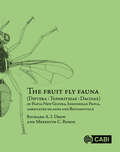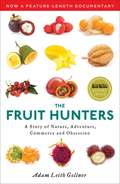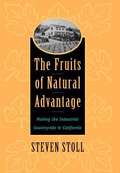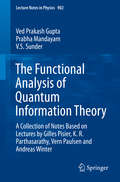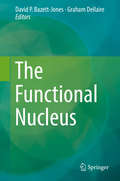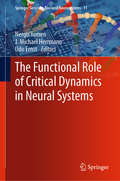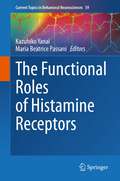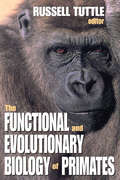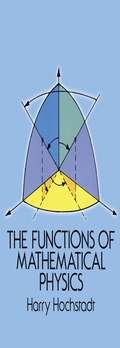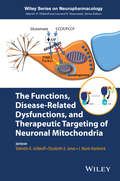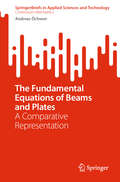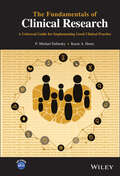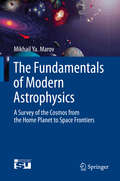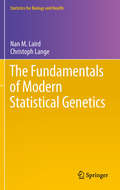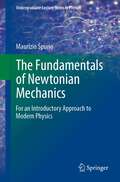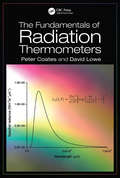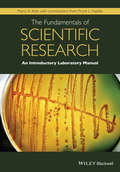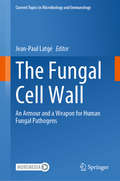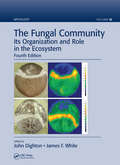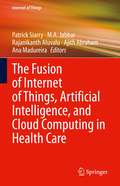- Table View
- List View
The Fruit Fly Fauna (Diptera : Tephritidae : Dacinae) of Papua New Guinea, Indonesian Papua, Associated Islands and Bougainville
by Richard Drew Meredith C RomigThe book is a taxonomic treatise of the tropical fruit flies of Papua New Guinea, Indonesian Papua, associated islands and Bougainville, the region of the world where speciation in the sub-family Dacinae has been most prolific. The book aims to provide readers with an updated record of all known species of Dacinae that occur in this geographic area including descriptions of 65 new species out of an entire list of 296 known species covered. It provides a discussion on the evolutionary origins of the Dacinae and a key to the genera and sub-genera recorded in the Australian-Pacific Region. Further, the major pest species and their biosecurity risks to other countries are discussed. Extensive field research by the authors and colleagues over many years has resulted in the accumulation of advanced knowledge of the tropical fruit flies in this region. - Records 296 known species - Descriptions and artwork of 65 new species - Discusses the evolutionary origins of the Dacinae - Provides a key to the genera and sub-genera in the Australian-Pacific A key reference for researchers of taxonomy, ecology and pest management in the family Tephritidae worldwide. Useful for biosecurity and horticulture workers in Agriculture Departments within government administration and universities around the world.
The Fruit Hunters: A Story of Nature, Adventure, Commerce, and Obsession
by Adam Leith GollnerDelicious, lethal, hallucinogenic and medicinal, fruits have led nations to war, fueled dictatorships and lured people into new worlds. An expedition through the fascinating world of fruit, The Fruit Hunters is the engrossing story of some of Earth's most desired foods. In lustrous prose, Adam Leith Gollner draws readers into a Willy Wonka-like world with mangoes that taste like piña coladas, orange cloudberries, peanut butter fruits and the miracle fruit that turns everything sour to sweet, making lemons taste like lemonade. Peopled with a cast of characters as varied and bizarre as the fruit -- smugglers, inventors, explorers and epicures -- this extraordinary book unveils the mysterious universe of fruit, from the jungles of Borneo to the prized orchards of Florida's fruit hunters to American supermarkets. Gollner examines the fruits we eat and explains why we eat them (the scientific, economic and aesthetic reasons); traces the life of mass-produced fruits (how they are created, grown and marketed) and explores the underworld of fruits that are inaccessible, ignored and even forbidden in the Western world. An intrepid journalist and keen observer of nature -- both human and botanical -- Adam Leith Gollner has written a vivid tale of horticultural obsession.
The Fruits of Natural Advantage: Making the Industrial Countryside in California
by Steven StollSteven Stoll explains how a class of capitalist farmers made California the nation's leading producer of fruit and created the first industrial countryside in America. This brilliant portrayal of California from 1880 to 1930 traces the origins, evolution, and implications of the fruit industry.
The Functional Analysis of Quantum Information Theory
by Ved Prakash Gupta Prabha Mandayam V. S. SunderThis book provides readers with a concise introduction to current studies on operator-algebras and their generalizations, operator spaces and operator systems, with a special focus on their application in quantum information science. This basic framework for the mathematical formulation of quantum information can be traced back to the mathematical work of John von Neumann, one of the pioneers of operator algebras, which forms the underpinning of most current mathematical treatments of the quantum theory, besides being one of the most dynamic areas of twentieth century functional analysis. Today, von Neumann's foresight finds expression in the rapidly growing field of quantum information theory. These notes gather the content of lectures given by a very distinguished group of mathematicians and quantum information theorists, held at the IMSc in Chennai some years ago, and great care has been taken to present the material as a primer on the subject matter. Starting from the basic definitions of operator spaces and operator systems, this text proceeds to discuss several important theorems including Stinespring's dilation theorem for completely positive maps and Kirchberg's theorem on tensor products of C*-algebras. It also takes a closer look at the abstract characterization of operator systems and, motivated by the requirements of different tensor products in quantum information theory, the theory of tensor products in operator systems is discussed in detail. On the quantum information side, the book offers a rigorous treatment of quantifying entanglement in bipartite quantum systems, and moves on to review four different areas in which ideas from the theory of operator systems and operator algebras play a natural role: the issue of zero-error communication over quantum channels, the strong subadditivity property of quantum entropy, the different norms on quantum states and the corresponding induced norms on quantum channels, and, lastly, the applications of matrix-valued random variables in the quantum information setting.
The Functional Nucleus
by David P. Bazett-Jones Graham DellaireThis book gives an in-depth overview on nuclear structure and function. It clearly shows that the epigenome and the three-dimensional organization of the nucleus are not independent properties. The intimate relationship between the location and the epigenetic modifications of gene loci is highlighted. Finally, it shows that the complex three-dimensional organization of the nucleus is not just of academic interest: The structure, composition and function of virtually all of the sub-nuclear compartments identified so far can be implicated to a list of human genetic diseases. Hence, a detailed elucidation of how these domains are assembled and function will provide new opportunities for therapeutic intervention in clinical practice.
The Functional Role of Critical Dynamics in Neural Systems (Springer Series on Bio- and Neurosystems #11)
by Nergis Tomen J. Michael Herrmann Udo ErnstThis book offers a timely overview of theories and methods developed by an authoritative group of researchers to understand the link between criticality and brain functioning. Cortical information processing in particular and brain function in general rely heavily on the collective dynamics of neurons and networks distributed over many brain areas. A key concept for characterizing and understanding brain dynamics is the idea that networks operate near a critical state, which offers several potential benefits for computation and information processing. However, there is still a large gap between research on criticality and understanding brain function. For example, cortical networks are not homogeneous but highly structured, they are not in a state of spontaneous activation but strongly driven by changing external stimuli, and they process information with respect to behavioral goals. So far the questions relating to how critical dynamics may support computation in this complex setting, and whether they can outperform other information processing schemes remain open. Based on the workshop “Dynamical Network States, Criticality and Cortical Function", held in March 2017 at the Hanse Institute for Advanced Studies (HWK) in Delmenhorst, Germany, the book provides readers with extensive information on these topics, as well as tools and ideas to answer the above-mentioned questions. It is meant for physicists, computational and systems neuroscientists, and biologists.
The Functional Roles of Histamine Receptors (Current Topics in Behavioral Neurosciences #59)
by Maria Beatrice Passani Kazuhiko YanaiResearch in the field of histamine receptors over the past 100 years went hand-in-hand with the development of modern pharmacology. Advances in histamine research led by outstanding scientists was so incisive that the clinical approach to treat allergies and gastrointestinal ailments was revolutionized. The pharmacological treatment of peptic ulcer and gastroesophageal reflux was indeed a revolution, as it ended the surgical intervention. Interest in histamine pharmacology was resurrected by the discovery of another histamine receptor, number 4, using genomics-based reverse pharmacological approaches for screening orphan GPCRs. This receptor is preferentially expressed by immune cells and its discovery raised hopes for its translational exploitation as a new therapeutic target for unmet medical needs ranging from asthma to cancer. However, several drawbacks emerged and dramatically slowed down research in the field. A better understanding of receptor intra-and interspecies heterogeneity will certainly improve and accelerate the translation of experimental data into clinical practice. Also, the plethora of data on brain histamine is hinting at a fundamental role of this system as a hub that receives internal and peripheral stimuli to allocate the necessary excitation to specific brain circuits that preside the appropriate behavioral responses. The development of new histaminergic ligands is an ongoing process that constantly provide new preclinical tools. The aim of this book is to cover the most important aspects of histamine receptor function and pharmacology in the central nervous system and to provide a comprehensive overview of the preclinical and clinical advances made in recent decades and the exciting prospects for the future. It highlights the clinical areas where there is a great need for new therapeutic approaches and where novel histaminergic agents may be useful for personalized medicine.
The Functional and Evolutionary Biology of Primates
by Russell TuttleThese original contributions on the evolution of primates and the techniques for studying the subject cover an enormous range of material and incorporate the work of specialists from many different fields, showing the necessity of a multidisciplinary approach to problems of primate morphology and phylogeny. Collectively, they demonstrate the concerns and methods of leading contemporary workers in this and related fields. Each contributor shows his way of attacking fundamental problems of evolutionary primatology.
The Functions of Mathematical Physics (Dover Books on Physics)
by Harry HochstadtA modern classic, this clearly written, incisive textbook provides a comprehensive, detailed survey of the functions of mathematical physics, a field of study straddling the somewhat artificial boundary between pure and applied mathematics.In the 18th and 19th centuries, the theorists who devoted themselves to this field -- pioneers such as Gauss, Euler, Fourier, Legendre, and Bessel -- were searching for mathematical solutions to physical problems. Today, although most of the functions have practical applications, in areas ranging from the quantum-theoretical model of the atom to the vibrating membrane, some, such as those related to the theory of discontinuous groups, still remain of purely mathematical interest.Chapters One and Two examine orthogonal polynomials, with sections on such topics as the recurrence formula, the Christoffel-Darboux formula, the Weierstrass approximation theorem, and the application of Hermite polynomials to quantum mechanics.Chapter Three is devoted to the principal properties of the gamma function, including asymptotic expansions and Mellin-Barnes integrals. Chapter Four covers hypergeometric functions, including a review of linear differential equations with regular singular points, and a general method for finding integral representations.Chapters Five and Six are concerned with the Legendre functions and their use in the solutions of Laplace's equation in spherical coordinates, as well as problems in an n-dimension setting. Chapter Seven deals with confluent hypergeometric functions, and Chapter Eight examines, at length, the most important of these -- the Bessel functions. Chapter Nine covers Hill's equations, including the expansion theorems.
The Functions, Disease-Related Dysfunctions, and Therapeutic Targeting of Neuronal Mitochondria
by Valentin K. Gribkoff J. Marie Hardwick Elizabeth A. JonasThis book presents advances in the field of neuronal mitochondria - functions, relation to therapeutics, and pharmacology. For scientists and researchers in both industry and academia, this book provides detailed discussion, examples, and approaches, to illustrate the potential of mitochondria as therapeutic targets for neuronal diseases. * Helps readers understand the regulation of mitochondrial cellular processes, such as substrate metabolism, energy production, and programmed versus sporadic cell death * Offers insights on the development of strategies for targeted therapeutic approaches and potential personalized treatments * Includes examples of mitochondrial drugs, development, and mitochondria-targeted approaches for more efficient treatment methods and further developments in the field * Covers the model systems and approaches needed for the development of new drugs for the central nervous system to provide potential modern therapeutics for neurodegenerative disorders
The Fundamental Equations of Beams and Plates: A Comparative Representation (SpringerBriefs in Applied Sciences and Technology)
by Andreas ÖchsnerThis book focuses on beam and plate elements, essential components found across various fields from automotive and aerospace engineering to civil engineering structures. It offers a comparative exploration of the fundamental equations governing thin and thick beams, as well as thin and thick plates, providing readers with a clear understanding of these foundational structural elements. By explaining the three fundamental equations of continuum mechanics—equilibrium, kinematics, and constitution—the text culminates in a unified differential equation framework, offering both beginners and experienced practitioners a fresh perspective on structural member modeling.
The Fundamentals of Atomic and Molecular Physics
by Robert L BrooksThe Fundamentals of Atomic and Molecular Physics is intended as an introduction to the field for advanced undergraduates who have taken quantum mechanics. Each chapter builds upon the previous, using the same tools and methods throughout. As the students progress through the book, their ability to use these tools will steadily increase, along with their confidence in their efficacy. The book treats the two-electron atom as the simplest example of the many-electron atom--as opposed to using techniques that are not applicable to many-electron atoms--so that it is unnecessary to develop additional equations when turning to multielectron atoms, such as carbon. External fields are treated using both perturbation theory and direct diagonalization and spontaneous emission is developed from first principles. Only diatomic molecules are considered with the hydrogen molecular ion and neutral molecule treated in some detail. This comprehensive coverage of the quantum mechanics of complex atoms and simple diatomic molecules, developed from the very basic components, is extremely useful for students considering graduate studies in any area of physics.
The Fundamentals of Clinical Research: A Universal Guide for Implementing Good Clinical Practice
by P. Michael Dubinsky Karen A. HenryThis book focuses on the practical application of good clinical practice (GCP) fundamentals and provides insight into roles and responsibilities included in planning, executing, and analyzing clinical trials. The authors describe the design of quality into clinical trial planning and the application of regulatory, scientific, administrative, business, and ethical considerations. Describes the design of quality into the clinical trial planning Has end-of-chapter questions and answers to check learning and comprehension Includes charts that visually summarize the content and allow readers to cross-reference details in relevant chapters Offers a companion website containing supplemental training resources
The Fundamentals of Horticulture
by Chris BirdEssential reading for all studying horticulture and keen gardeners. This clear introduction to the principles underlying the practical applications of horticulture opens up the excitement of growing plants and garden development without readers wading through complex information. Written by a team of highly motivated and experienced horticultural tutors, the text supports the newly restructured RHS Level 2 qualifications with related Level 3 topics in boxes and signposting to Level 4 topics, together with other horticultural qualifications at these levels. Full colour images tied closely to the text and practical case study boxes inspire readers by making topics relevant to their own horticultural experiences. A comprehensive glossary helps build confidence in the use of classical horticulture language as well as new developing terms, and end-of-chapter questions encourage readers to apply what they have learnt. Extensive online supporting material includes mind maps showing the relationship of topics and aiding students in revision.
The Fundamentals of Modern Astrophysics
by Mikhail Ya. MarovThe Fundamentals of Modern Astrophysics provides an overview of the modern science of astrophysics. It covers the Sun, Solar System bodies, exoplanets, stars, and star life cycle, planetary systems origin and evolution, basics of astrobiology, our galaxy the Milky Way, other galaxies and galactic clusters, a general view of the Universe, its structure, evolution and fate, modern views and advanced models of cosmology as well as the synergy of micro- and macro physics, standard model, superstring theory, multiversity and worm holes. The main concepts of modern astrophysics and prospects for future studies are accompanied by numerous illustrations and a summary of the advanced projects at various astronomical facilities and space missions. Dr. Marov guides readers through a maze of complicated topics to demystify the field and open its wonders to all.
The Fundamentals of Modern Statistical Genetics
by Nan M. Laird Christoph LangeThis book covers the statistical models and methods that are used to understand human genetics, following the historical and recent developments of human genetics. Starting with Mendel's first experiments to genome-wide association studies, the book describes how genetic information can be incorporated into statistical models to discover disease genes. All commonly used approaches in statistical genetics (e.g. aggregation analysis, segregation, linkage analysis, etc), are used, but the focus of the book is modern approaches to association analysis. Numerous examples illustrate key points throughout the text, both of Mendelian and complex genetic disorders. The intended audience is statisticians, biostatisticians, epidemiologists and quantitatively- oriented geneticists and health scientists wanting to learn about statistical methods for genetic analysis, whether to better analyze genetic data, or to pursue research in methodology. A background in intermediate level statistical methods is required. The authors include few mathematical derivations, and the exercises provide problems for students with a broad range of skill levels. No background in genetics is assumed.
The Fundamentals of Newtonian Mechanics: For an Introductory Approach to Modern Physics (Undergraduate Lecture Notes in Physics)
by Maurizio SpurioClassical mechanics is the basis for any university-level study of technical-scientific disciplines. But most existing manuals use a technological and engineering approach, with basic aspects sometimes insufficiently highlighted. This book introduces the concepts and applications of classical mechanics into Newtonian formalism. Newtonian dynamics is useful for solving applied physics and engineering problems, but also a fascinating theory anchored in questions posed since the times of the Greek philosophers, regarding space, the flow of time, measurable physical quantities, the physical principles with the mathematical structure needed to describe the Universe, etc. The author aims to encourage students to think about these fundamental aspects and how they will be addressed in modern physics, including the successes and limitations of Newton's mechanics. The book is designed to mirror the progress of the students using it, with earlier chapters assuming no more than basic high school instruction and later ones geared toward subsequent enhanced understanding. The book is designed for students of undergraduate programs in physics, mathematics, chemistry, and engineering who will deal with modern physics, as they will benefit from an approach in which the aspects of classical mechanics are introduced in a propaedeutic approach towards relativistic physics and quantum mechanics.
The Fundamentals of Radiation Thermometers
by Peter Coates David LoweAuthored by two highly respected experts in this specialist area, The Fundamentals of Radiation Thermometers is an essential resource for anyone intending to measure the temperature of an object using the radiated energy from that object. This readable, user-friendly book gives important background knowledge for anyone working in the field of non-contact thermometry. The book begins with an accessible account of how temperature scales are set up and defined, and explores the historic development of temperature scales and Planck’s radiation law. Through explaining the reliability of both emissivity values and extrapolation to different wavelengths and temperatures, the book provides a foundation for understanding when a valid measurement with realistic uncertainties has been made, or if an inappropriate emissivity value has been used with consequent unknown errors. The book also presents the hardware of radiation thermometers, allowing the reader to specify an appropriate design for a particular measurement problem. It explores multi-wavelength radiation thermometry and its associated pitfalls, and a final chapter suggests strategies to minimise the uncertainties from unreliable emissivity data.
The Fundamentals of Scientific Research
by Marcy A. Kelly Pryce L. HaddixThe Fundamentals of Scientific Research: An Introductory Laboratory Manual is a laboratory manual geared towards first semester undergraduates enrolled in general biology courses focusing on cell biology. This laboratory curriculum centers on studying a single organism throughout the entire semester - Serratia marcescens, or S. marcescens, a bacterium unique in its production of the red pigment prodigiosin. The manual separates the laboratory course into two separate modules. The first module familiarizes students with the organism and lab equipment by performing growth curves, Lowry protein assays, quantifying prodigiosin and ATP production, and by performing complementation studies to understand the biochemical pathway responsible for prodigiosin production. Students learn to use Microsoft Excel to prepare and present data in graphical format, and how to calculate their data into meaningful numbers that can be compared across experiments. The second module requires that the students employ UV mutagenesis to generate hyper-pigmented mutants of S. marcescens for further characterization. Students use experimental data and protocols learned in the first module to help them develop their own hypotheses, experimental protocols, and to analyze their own data. Before each lab, students are required to answer questions designed to probe their understanding of required pre-laboratory reading materials. Questions also guide the students through the development of hypotheses and predictions. Following each laboratory, students then answer a series of post-laboratory questions to guide them through the presentation and analysis of their data, and how to place their data into the context of primary literature. Students are also asked to review their initial hypotheses and predictions to determine if their conclusions are supportive. A formal laboratory report is also to be completed after each module, in a format similar to that of primary scientific literature. The Fundamentals of Scientific Research: An Introductory Laboratory Manual is an invaluable resource to undergraduates majoring in the life sciences.
The Fundamentals of Thermodynamics (Fundamental Theories of Physics #221)
by Roman Frigg David A. LavisThe aim of this text is to provide an account of the fundamentals of thermodynamics which is accessible at graduate level to physicists, mathematicians and philosophers of physics. The bulk of the book (Chapters 2-9) is based on the algebraic approach of Lieb and Yngvason, but extended to encompass both positive and negative temperatures and systems in which entropy increases and decreases in adiabatic processes. We show that these four possibilities are already present in Carathéodory's version of the Second Law which arises as a theorem from the axioms. We develop generalized versions of the Kelvin-Planck and Clausius formulations valid for the same range of systems. The parallel development in Chapter 10 takes a geometric approach. We discuss the limitations associated with the local nature of Carathéodory's Principle and present the resolution of this problem due to Boyling. Part of the aim here is to substantiate the claim of Arnold that the mathematical structure of thermodynamics is contact geometry. The last two chapters of the book extend the scope of the discussion to, respectively, critical phenomena and non-equilibrium systems. Chapter 11 is a presentation of phase transitions and critical phenomena in which we discuss universality and use scaling theory to derive scaling laws. Chapter 12 contains a generalization to non-equilibrium. We present the extension of Lieb and Yngvason's work to non-equilibrium and also give a brief account of classical irreversible thermodynamics (CIT). The latter enables a possible understanding of the way that the lack of a unique entropy function in the Lieb and Yngvason non-equilibrium approach can be resolved. The book is completed by a set of appendices which provide mathematical and physical support to the work in the main text.
The Fungal Cell Wall: An Armour and a Weapon for Human Fungal Pathogens (Current Topics in Microbiology and Immunology #425)
by Jean-Paul LatgéThis book illustrates, that the fungal cell wall is critical for the biology and ecology of all fungi and especially for human fungal pathogens. Readers will learn, that the composition of the fungal cell wall is a unique structure, which cannot be found in the human host. Consequently, the chapters outline, how the immune systems of both animals and humans have evolved to recognize conserved and unique elements of the fungal cell wall. As an application example, the authors also show, that the three-dimensional structures of the cell wall are excellent targets for the development of antifungal agents and chemotherapeutic strategies. With the combination of biological findings and medical outlooks, this volume is a fascinating read for scientists, clinicians and biomedical students.
The Fungal Community: Its Organization and Role in the Ecosystem, Fourth Edition (Mycology)
by James F. White John Dighton"…a number of chapters provide excellent summaries of the modern methods available for studying fungal ecology, along with those more traditional methods that are still extremely valuable…overall it is a hugely valuable compendium of fungal ecology research. It is a must for the library shelf." -Lynne Boddy, Cardiff University, UK, Mycological Research, 2006"These 44 chapters are an excellent starting point for anyone interested in fungal communities, in the broadest sense of the term. It is a book for dipping into…may be the last comprehensive treatment of fungal communities before the molecular revolution."-Meriel Jones, University of Liverpool, UK, Microbiology Today "… the scope of the work is tremendous. … Excellent chapters providing overviews of methods … provide a snap shot of the current approaches used to understand fungal communities at several levels of organization. This book should probably be on the shelf of every student of mycology, and many ecologists too. For all students, this book should be a valuable resource and source of inspiration." -Daniel Henk, Imperial College Faculty of Medicine, London, in Inoculum, Vol. 59, No. 3, May 2008 "Thorough taxonomic and subject indices further aid the reader in navigating through multiple authors’ treatments of subjects of interest." - Anthony Amend, Department of Botany, University of Hawaii at Manoa in Economic Botany, V. 61 In all subjects in science, new findings and the use of new technologies allow us to develop an ever-greater understanding of our world. Expanded and updated coverage in the fourth edition includes: Adds new sections on Integrating Genomics and Metagenomics into Community Analysis, Recent Advances in Fungal Endophyte Research, Fungi in the Built Environment, and Fungal Signaling and Communication Includes a broader treatment of fungal communities in natural ecosystems with in-depth coverage of fungal adaptations to stress and conservation Expands coverage of the influence of climate change on fungi and the role of fungi in organically polluted ecosystems Includes contributions from scientists from 20 nations to illustrate a true global approach for bridging gaps between ecological concepts and mycology
The Funny Society
by Lorenzo BonanniThe book describes scientifically but with a simple terminology, sometimes with irony and humour, the evolutionary and ethological reasons of the love and hate within the couple, why we use deception, why we are attracted to flowers.
The Furry Animal Alphabet Book (Jerry Pallotta's Alphabet Books)
by Jerry PallottaThis fact-filled text with richly-detailed illustrations introduces not only the alphabet but also the wonders of the mammal world.What mammal jumps ten feet high to avoid hungry lions?What monkey almost always gives birth to twins?What mammal has a nose so large that it has to be moved out the way just to eat?What mammal has eyes that are bigger than its brain?Jerry Pallotta and Edgar Stewart deliver an intriguing book which will fascinate young children.
The Fusion of Internet of Things, Artificial Intelligence, and Cloud Computing in Health Care (Internet of Things)
by Ajith Abraham Patrick Siarry Ana Madureira M. A. Jabbar Rajanikanth AluvaluThis book reviews the convergence technologies like cloud computing, artificial intelligence (AI) and Internet of Things (IoT) in healthcare and how they can help all stakeholders in the healthcare sector. The book is a proficient guide on the relationship between AI, IoT and healthcare and gives examples into how IoT is changing all aspects of the healthcare industry. Topics include remote patient monitoring, the telemedicine ecosystem, pattern imaging analytics using AI, disease identification and diagnosis using AI, robotic surgery, prediction of epidemic outbreaks, and more. The contributors include applications and case studies across all areas of computational intelligence in healthcare data. The authors also include workflow in IoT-enabled healthcare technologies and explore privacy and security issues in healthcare-based IoT.
